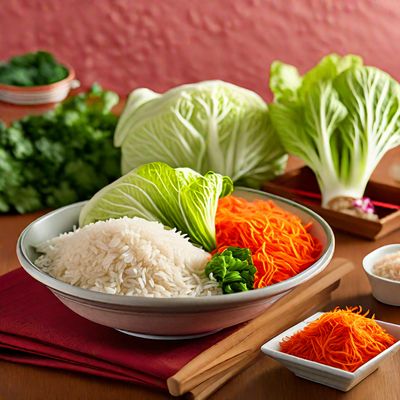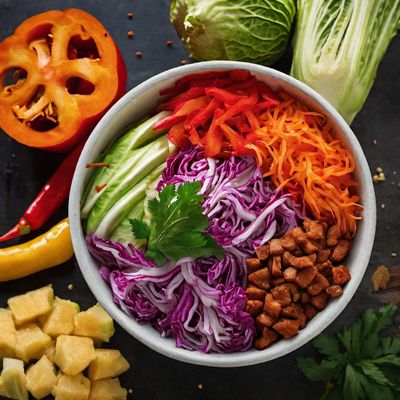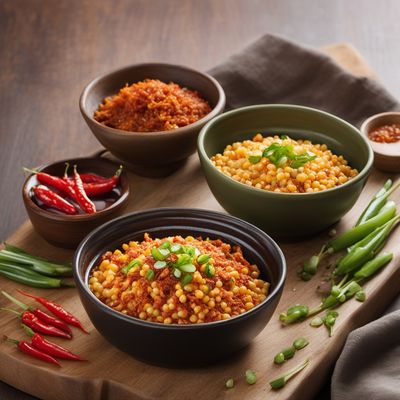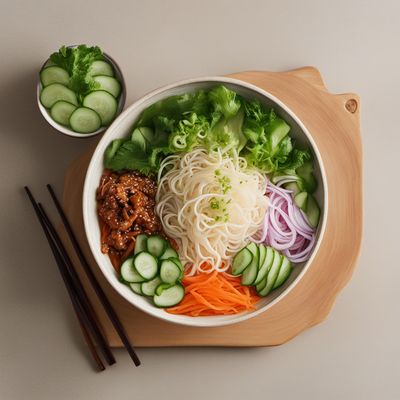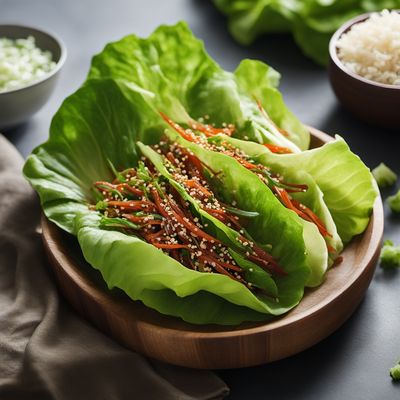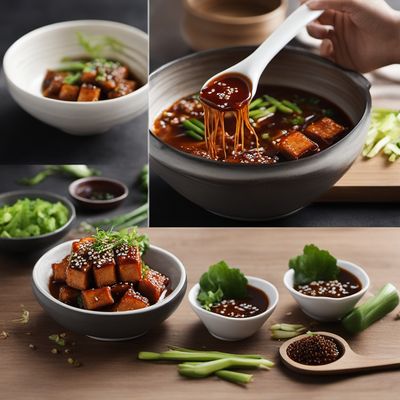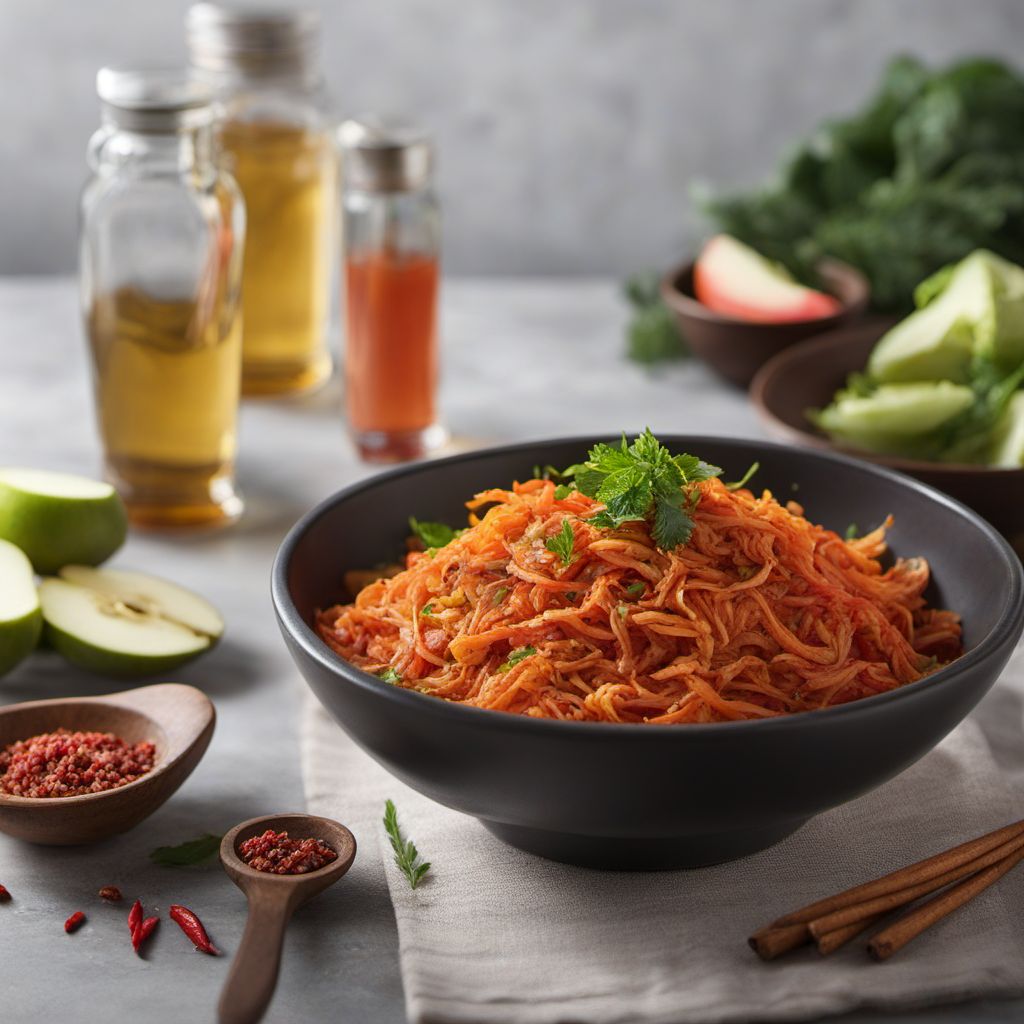
Recipe
Israeli-style Spicy Pickled Cabbage
Zesty Israeli Kimchi: A Fusion of Flavors
4.8 out of 5
This recipe combines the vibrant flavors of Israeli cuisine with the traditional Korean dish of kimchi. Israeli-style Spicy Pickled Cabbage is a tangy and fiery side dish that adds a burst of flavor to any meal.
Metadata
Preparation time
20 minutes
Cooking time
N/A
Total time
2-3 days (including fermentation)
Yields
4 servings
Preparation difficulty
Easy
Suitable for
Vegan, Vegetarian, Gluten-free, Dairy-free, Low calorie
Allergens
N/A
Not suitable for
Paleo, Keto, Nut-free, Soy-free, Egg-free
Ingredients
Israeli-style Spicy Pickled Cabbage differs from traditional Korean kimchi in terms of the spices and herbs used. While Korean kimchi typically incorporates ingredients like gochugaru (Korean red pepper flakes) and fish sauce, this Israeli adaptation replaces them with Israeli spices and herbs, giving it a unique flavor profile that complements Israeli cuisine. We alse have the original recipe for Kimchi, so you can check it out.
-
1 large head of cabbage, shredded (900g / 2 lbs) 1 large head of cabbage, shredded (900g / 2 lbs)
-
3 tablespoons kosher salt (45g) 3 tablespoons kosher salt (45g)
-
2 tablespoons ground cumin (14g) 2 tablespoons ground cumin (14g)
-
1 tablespoon ground coriander (7g) 1 tablespoon ground coriander (7g)
-
1 tablespoon paprika (7g) 1 tablespoon paprika (7g)
-
1 tablespoon turmeric (7g) 1 tablespoon turmeric (7g)
-
1 tablespoon crushed red pepper flakes (7g) 1 tablespoon crushed red pepper flakes (7g)
-
4 cloves garlic, minced 4 cloves garlic, minced
-
1 tablespoon fresh ginger, grated 1 tablespoon fresh ginger, grated
-
2 tablespoons honey (30ml) 2 tablespoons honey (30ml)
-
1 cup apple cider vinegar (240ml) 1 cup apple cider vinegar (240ml)
-
1 cup water (240ml) 1 cup water (240ml)
Nutrition
- Calories (kcal / KJ): 70 kcal / 293 KJ
- Fat (total, saturated): 0g, 0g
- Carbohydrates (total, sugars): 17g, 10g
- Protein: 2g
- Fiber: 4g
- Salt: 3g
Preparation
-
1.In a large bowl, combine the shredded cabbage and kosher salt. Massage the salt into the cabbage for about 5 minutes to help release its juices.
-
2.Rinse the cabbage under cold water to remove excess salt. Drain well and set aside.
-
3.In a small bowl, mix together the ground cumin, ground coriander, paprika, turmeric, crushed red pepper flakes, minced garlic, grated ginger, honey, apple cider vinegar, and water.
-
4.Place the cabbage in a clean, sterilized jar or airtight container. Pour the spice mixture over the cabbage, ensuring it is fully submerged.
-
5.Close the jar or container tightly and let it sit at room temperature for 2-3 days to allow the flavors to develop and the cabbage to ferment.
-
6.After the fermentation period, transfer the Israeli-style Spicy Pickled Cabbage to the refrigerator. It can be enjoyed immediately, but the flavors will continue to develop over time.
Treat your ingredients with care...
- Cabbage — Make sure to thoroughly rinse the cabbage after massaging it with salt to remove excess saltiness.
- Crushed red pepper flakes — Adjust the amount according to your desired level of spiciness.
- Apple cider vinegar — Use raw, unfiltered apple cider vinegar for the best flavor.
Tips & Tricks
- For a milder version, reduce the amount of crushed red pepper flakes.
- Allow the Israeli-style Spicy Pickled Cabbage to ferment for longer if you prefer a stronger tangy flavor.
- Serve as a side dish with falafel, grilled meats, or as a topping for sandwiches and wraps.
- Experiment with adding other Israeli spices like za'atar or sumac for additional flavor variations.
- Store the pickled cabbage in the refrigerator for up to 2 weeks.
Serving advice
Israeli-style Spicy Pickled Cabbage can be served as a side dish alongside various Israeli dishes such as falafel, hummus, or shawarma. It also pairs well with grilled meats and can be used as a topping for sandwiches and wraps.
Presentation advice
To enhance the presentation, garnish the Israeli-style Spicy Pickled Cabbage with fresh herbs such as parsley or cilantro. Serve it in a colorful dish or jar to showcase its vibrant red color.
More recipes...
More Korean cuisine dishes » Browse all
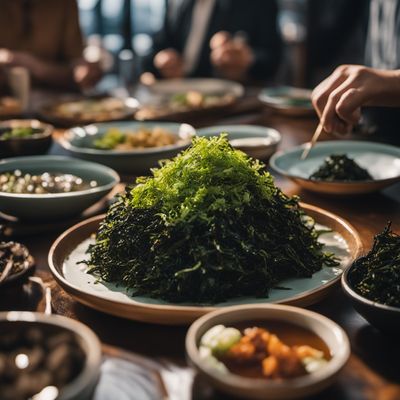
Gim gui
Roasted Seaweed
Gim gui is a Korean dish made from grilled seaweed.

Hodu-gwaja
Walnut Cookies
Hodu-gwaja, also known as walnut cookies, are a popular Korean treat. These cookies are made with a sweet dough and filled with a mixture of...

Wanjajeon
Korean meatballs
Wanjajeon is a traditional Korean dish that is made with pan-fried meatballs. The dish is typically served as an appetizer or as a main course...
More Israeli cuisine dishes » Browse all

Sabich
Eggplant and egg sandwich
Sabich is a popular Israeli street food that is packed with flavor and nutrition. Made with a variety of fresh vegetables and spices, this dish is...

Salatim
Salatim is a Hebrew term for a variety of small dishes served as side dishes with bread and hummus. These dishes are meant to be shared and are an...

Israeli Breakfast
The Israeli breakfast is a hearty and flavorful meal that is typically served as a brunch item.
